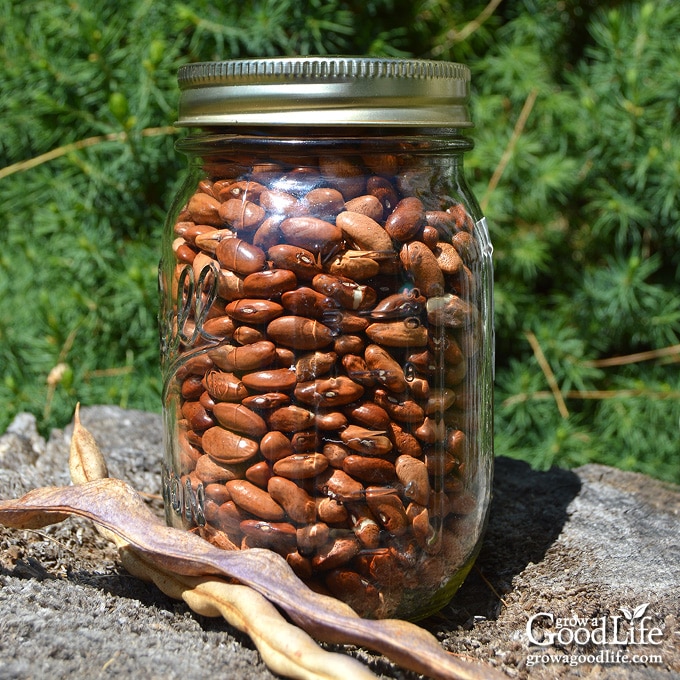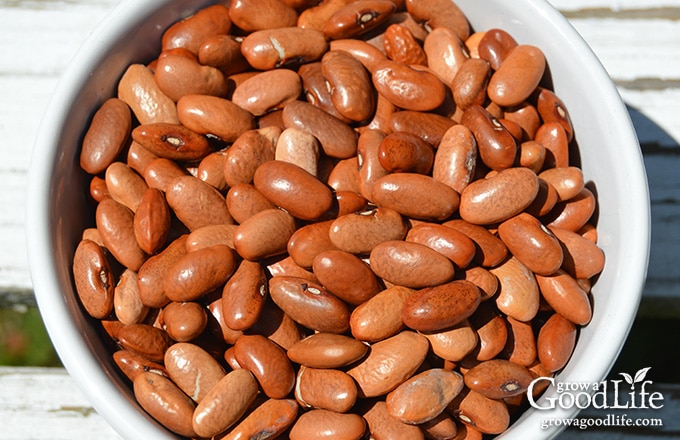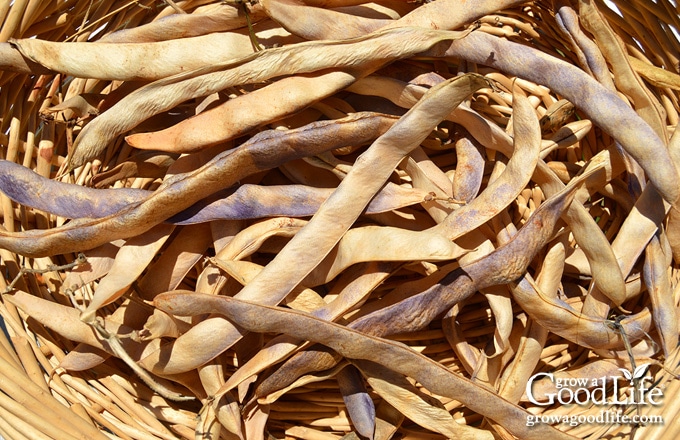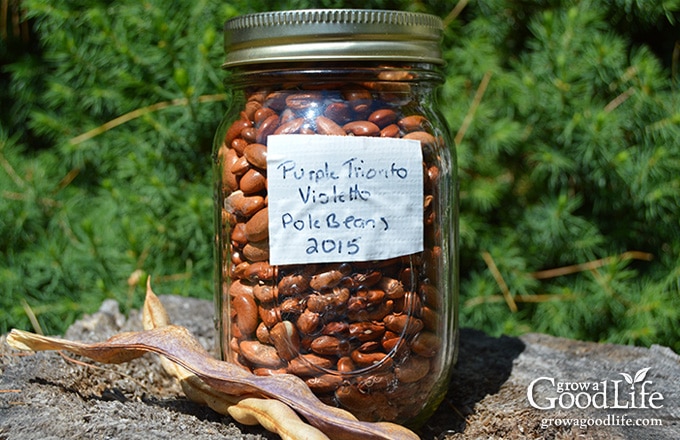How to Save Bean Seeds to Plant Next Year
This post may contain affiliate links, which means that I may receive a commission if you make a purchase using these links. As an Amazon Associate I earn from qualifying purchases.
Saving bean seeds is an easy and thrifty way to keep growing your favorite variety year after year. Learn how to harvest the seeds from your bean plants, and how to store them for next year’s growing season.

Seed saving is a good way to spare some money in the gardening budget, become more self-sufficient, and adapt a crop to your unique growing conditions. One of the easiest seeds for beginners is open-pollinated, heirloom bean seeds.
The common bean (Phaseolus vulgaris) is a grain legume grown for its edible seeds and pods. Numerous cultivars of beans have been developed, including green beans, shelling beans, and dried beans.
Plants are divided into two categories, bush beans and pole beans. Bush beans grow about 1 to 3 feet and tend to produce their crop around the same time. While pole beans grow 6 to 12 feet on poles or trellis supports, and continues to produce new pods until frost.
Beans are a good crop to start with if you are brand new to seed saving. Bean seeds are large and easy to see and handle. Other than drying, there is no special process required to prepare the seeds for storage.
Beans are self-pollinating and pollination usually happens even before the blossom opens. So they are less likely to cross-pollinate even when growing close to each other. However, to be on the safe side, try to plant different varieties of beans at least 10 to 20 feet from one another if you are saving seeds to avoid cross pollination.

Steps to Saving Bean Seeds
If you want to save bean seeds, you need to get the plants started early so they have plenty of time to mature fully before fall frost. Beans need warm temperatures and lots of moisture to grow, so try to plant them in early summer for seed saving.
Check out this article on how to grow beans to get your plants started, and then follow the steps below to save seeds:
Step 1: Plant Open-Pollinated Bean Seeds
Grow open-pollinated or heirloom varieties and not hybrids for seed saving. All heirloom plants are open-pollinated, and have developed naturally over years. Saving seeds from open-pollinated plants will result in a plant that has the same characteristics as the parent plant. Plants can also adapt over time to grow well in your garden environment.
Plant breeders create hybrids by cross-pollinating closely related varieties for a desired trait such as disease resistance, larger yield, or color. Plants grown from hybrid seeds don’t usually breed true when seeds are saved and planted the following year.
Step 2: Choose Healthy Plants
Select the heartiest and most vigorous plants to harvest bean seeds for next year’s crop. Do not save seeds from weak or diseased plants, or plants that are infested with pests.
Choose plants that grow quickly, with healthy foliage and vines, and pods that are well developed with plenty of even sized seeds. These will be the healthiest plants to harvest.
Depending on your seed needs, you may need to save just one or two plants to produce a seed crop. Green beans generally average 6 seeds per pod, and most plants produce over 20 pods per plant. So the potential is around 120 seeds per plant!
Step 3: Let the Plants Go
Allow the bean pods to mature fully on the plant. The seeds will fill out the pod as they grow. Then the pod will begin to turn yellow and brown as the pods and bean seeds dry. Seed maturity can take up 4 to 6 weeks, depending on the variety.
Keep in mind, when you allow the pods to mature on the plant, the plant will focus its energy on ripening those seeds, and will stop producing new pods. So either harvest some beans before allowing the plant to go to seed, or dedicate a growing bed to producing seeds only.
Step 4: Collect the Pods
The bean pods should feel papery and dry when ready. You should hear the bean seeds rattle when you shake the pod. Once the pods are dry, pick the beans from the plants to dry further indoors. Be sure to harvest all the pods before frost.
If the pods are not dry before the first frost, pull the whole plants and let them dry further indoors. I tie the plants together, and let them hang from the ceiling in my basement.

Step 5: Dry Out the Bean Seeds
Spread the dried pods in a single layer on a drying screen and let them dry further in a well-ventilated location, until the pods are papery and brittle. Dry for at least two weeks before testing the bean seeds.
Step 6: Test the Seeds
Shell a pod and test several bean seeds with your fingernail. Press your fingernail into the seeds. If it leaves a dent, the seeds need to dry longer. You can also test the beans by hitting them with a hammer. The bean seeds will shatter when they are completely dry.
Step 7: Shell and Store
Once your bean seeds are dry, remove them from the pods, and freeze them to kill any weevils that may be in the seeds. Place the dried beans in a freezer bag, seal, and place in the freezer for about a week. Then remove the bag, spread out the beans in a single layer to let them thaw and evaporate moisture for about a day.
Place your dry beans in an airtight container. Label with the name of the beans and the year collected. Store your seeds in a dark and cool location, at a temperature between 32˚F to 42˚F.
Bean seeds will last up to 4 years when stored properly. If your seeds are older, try this Seed Germination Test to check to see if the seeds are still viable before planting.

Saving bean seeds is an easy and thrifty way to keep growing your favorite varieties year after year. Not only is it a great way to save money, but it also allows you to maintain the quality and taste of your favorite beans. So next time you’re growing beans, be sure to save some of the seeds for future planting!
You May Also Like:
- Tips for Buying Seeds for your Vegetable Garden
- 13 Easy Vegetables to Direct Sow
- 3 Succession Planting Tips to Maximize Your Harvest
Good planning is key to a successful vegetable garden
Whether you are new to growing your own food or have been growing a vegetable garden for years, you will benefit from some planning each year. You will find everything you need to organize and plan your vegetable garden in my PDF eBook, Grow a Good Life Guide to Planning Your Vegetable Garden.


in the article it said to store bean seed in 32-42 degrees. I don’t have a root cellar or basement. can they be store in a frig? to keep in that temperature range
Stanley, Yes, absolutely! Storing bean seeds in the refrigerator is a great option, especially if you’re aiming for long-term preservation and want them to last for years. However, if you plan to use the seeds within a year or two, any cool spot away from direct heat and sunlight will suffice.
Hi! I had several pole beans this year that we let get too big on the vine. I went ahead and picked them and then let them dry on my counter. Will the bean “seeds” from these work to replant or do they really have to dry on the vine to be good for planting. Thanks!
Melissa, It depends on if the beans had time to fully mature on the vine. You could try testing a few to see if they sprout: How to Test Seeds
Since I live in a warm climate, I am hoping to have two showings in a year. Can I plant seeds that are in their pods right away if the pods are dry?
Carol, I haven’t tried re-planting the seeds right away. My understanding is seeds need to be dried completely and require a dormant period before planting. This rest period allows the seed coat to cure properly, forming a protective barrier that prevents it from soaking up too much moisture and rotting. You could try a few and see how they do.
I planted Bush beans this year from seed that I harvested last year. The seed last year was white and I got beautiful beans this year. I have let a row turn to seed. Some of the seeds are white and some of them are dark brown can you tell me why?
Tina, The beans could have cross-pollinated or a recessive trait may have emerged. Cross-pollination does not happen very easily, but it is possible. I would go ahead and separate the colors into groups, and plant the seeds next year and see what happens.
I have a question: my yellow beans keep on sprouting and now sur how to dry them up out of their shell. Also what would you recommend best for storage containers.
Ghislaine, Have you followed the instructions in the article? The seeds must be absorbing moisture if they are sprouting. You need to let them dry completely, and then store them in an airtight container.